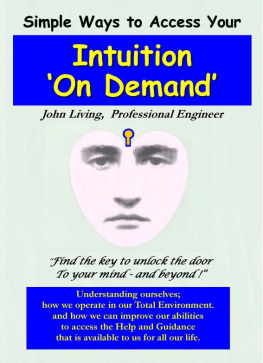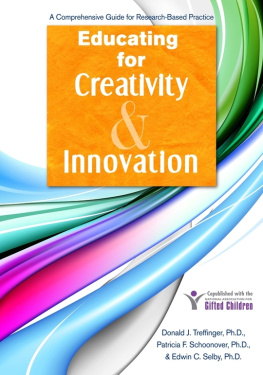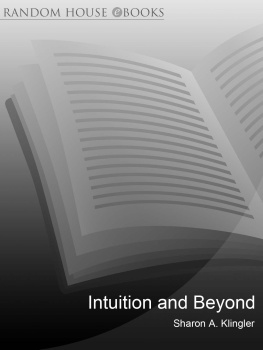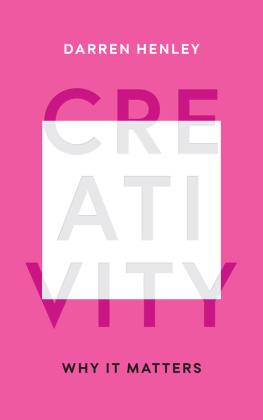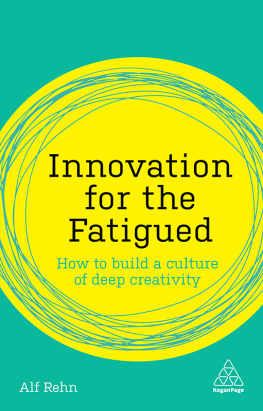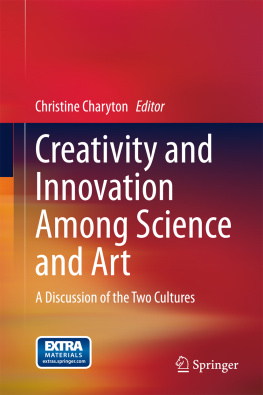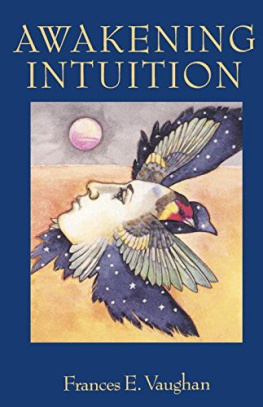Samier - Intuition, Creativity, Innovation
Here you can read online Samier - Intuition, Creativity, Innovation full text of the book (entire story) in english for free. Download pdf and epub, get meaning, cover and reviews about this ebook. year: 2019;2018, publisher: John Wiley & Sons, Incorporated, genre: Romance novel. Description of the work, (preface) as well as reviews are available. Best literature library LitArk.com created for fans of good reading and offers a wide selection of genres:
Romance novel
Science fiction
Adventure
Detective
Science
History
Home and family
Prose
Art
Politics
Computer
Non-fiction
Religion
Business
Children
Humor
Choose a favorite category and find really read worthwhile books. Enjoy immersion in the world of imagination, feel the emotions of the characters or learn something new for yourself, make an fascinating discovery.
- Book:Intuition, Creativity, Innovation
- Author:
- Publisher:John Wiley & Sons, Incorporated
- Genre:
- Year:2019;2018
- Rating:3 / 5
- Favourites:Add to favourites
- Your mark:
- 60
- 1
- 2
- 3
- 4
- 5
Intuition, Creativity, Innovation: summary, description and annotation
We offer to read an annotation, description, summary or preface (depends on what the author of the book "Intuition, Creativity, Innovation" wrote himself). If you haven't found the necessary information about the book — write in the comments, we will try to find it.
Samier: author's other books
Who wrote Intuition, Creativity, Innovation? Find out the surname, the name of the author of the book and a list of all author's works by series.
Intuition, Creativity, Innovation — read online for free the complete book (whole text) full work
Below is the text of the book, divided by pages. System saving the place of the last page read, allows you to conveniently read the book "Intuition, Creativity, Innovation" online for free, without having to search again every time where you left off. Put a bookmark, and you can go to the page where you finished reading at any time.
Font size:
Interval:
Bookmark:

Series Editor
Bruno Salgues
Henri Samier

First published 2018 in Great Britain and the United States by ISTE Ltd and John Wiley & Sons, Inc.
Apart from any fair dealing for the purposes of research or private study, or criticism or review, as permitted under the Copyright, Designs and Patents Act 1988, this publication may only be reproduced, stored or transmitted, in any form or by any means, with the prior permission in writing of the publishers, or in the case of reprographic reproduction in accordance with the terms and licenses issued by the CLA. Enquiries concerning reproduction outside these terms should be sent to the publishers at the undermentioned address:
ISTE Ltd
27-37 St Georges Road
London SW19 4EU
UK
www.iste.co.uk
John Wiley & Sons, Inc.
111 River Street
Hoboken, NJ 07030
USA
www.wiley.com
ISTE Ltd 2018
The rights of Henri Samier to be identified as the author of this work have been asserted by him in accordance with the Copyright, Designs and Patents Act 1988.
Library of Congress Control Number: 2018957210
British Library Cataloguing-in-Publication Data
A CIP record for this book is available from the British Library
ISBN 978-1-78630-291-5
The current paradigm shift is bringing about a new era of meaning, connection and agility that affects the societal, ecological, political, economic and technological environment. Now more than ever, the classic rationality approach is showing its limitations and the intuition approach seems a possible complementary approach. Intuition can make it easier to move on to this new era and provide collective, connective and individual help.
Initially, what motivated this work was contradictory research on intuition. The goal was to demonstrate scientifically that intuition does not exist, that it results from random coincidences and therefore that it could not be proved. Scientific, literary and practical studies and lines of thought led us over the course of more than 7 years to research the existence of connections between these fields, such as acoustics and medicine, which on a basic level were unrelated.
The results of our research have shown that intuition was an actual and unexplainable phenomenon, and because of determination, perseverance and scientific insight, we can demonstrate that intuition does indeed exist and that it takes different shapes.
The original assumption that intuition was a random phenomenon was therefore false and its non-existence could still be proved. Step by step, we have accepted its unscientific existence and then, experiment after experiment, we have established an approach associated with exercises whose goal is to accept to feel and develop ones intuition. After extensive studies and several experiments involving different audiences in France and abroad, we have discovered the connections that account for the phenomenon of intuition as vibratory, observable and reproducible. Based on this observation and the significant change in the way we dealt with intuition, we then attempted to convey and teach intuition. After a series of experiments, we have been able to establish a way of approaching intuition whose goal is to allow anyone to feel and employ it. Everyone can intuit, even those who still think they cannot. Intuition is definitely not reserved for the so-called more sensitive individuals.
In this respect, we wish to thank the individuals who attended our seminars and courses on intuition, which we organized in France and Asia in the sphere of higher education and in companies.
This work is intended for anyone who wishes to discover, develop or amplify his or her intuition, creativity and innovation ability. The triad of intuition, creativity and innovation will be developed from a human and methodological perspective, revealing the rich connections between these three fields.
Based on the scientific foundations of intuition, and in particular on cymatics, we put forward a method that makes it possible to feel the perceptible signs of ones intuition. The exercises included in this method allow us to mix our rationality with our intuition by listening to music, kinesthesia and paying attention to our own body, among other things. The exercises lead us, on the one hand, to understand the phenomenon of intuition and, on the other hand, to change our attitude toward the phenomena that science can or cannot explain. If a phenomenon cannot be explained, it is perhaps due to a lack of measuring tools, physical models or mathematical theories.
This work puts forward a series of exercises whose goal is to minimize the opposition and lessen the obstacles involved in our relation to intuition. The awareness reached due to the recommended videos, breathing and feeling exercises, as well as exercises involving body language in music allows us to dig deeper and affects personal changes in the long term. The blocks or barriers to intuition mainly manifest themselves as fears and beliefs that must be rejected to be able to intuit.
This objective resulted from the question we asked: how can the creativity and innovation of students, engineering students and business executives be improved? Thus, we carried out experiments in different educational and research environments, such as the ISTIA Innovation, the University of Angers, Cholet and Saumur, and schools like the Arts et Mtiers ParisTech in Paris, AUDENCIA, the ECP in Paris, the CESI in Saint-Nazaire and the INSA in Rennes.
We observed through these experiments that some individuals substantially developed their creative abilities and filed for patents, whereas others mastered creative techniques without, however, being able to reach concrete results. The difference in creative potential depended on the individuals profile and their way of receiving and implementing creative approaches.
Let us compare human beings to a car. This is an interesting metaphor. A car will be faster and sturdier, and it will perform better, if we improve and optimize its engine power, the aerodynamism of its body, the rigidity of its chassis and the grip of its tires, the speed remaining constant. This holds true regardless of the car model. On the other hand, this does not work systematically for human beings, as human factors are much more complex than mechanical parameters. Therefore, we decided to work on the human factor in creative processes and we developed new methods that allow everyone to be truly creative.
In the context of our research, we tested some levers to make individuals more creative in their thinking and behaviors because of the hybridizations between creativity, intuition and innovation, and we can now present our results in this work.
However, intuition is a complex and thorny subject, questioned by the scientific community to which we belong. A phenomenon that does not follow the observers independent observation, measurement and modeling steps cannot be reproduced for now. What cannot be reproduced each time is excluded from a scientific outline, where experiments must be reproducible regardless of the observers. Thanks to cymatics, we will explain the causal and vibratory phenomenon of intuition.
Our passion for teaching has always led us to explore different ways of passing down knowledge; today, neuroscience gives us the opportunity of testing new innovative pedagogical approaches.
Next pageFont size:
Interval:
Bookmark:
Similar books «Intuition, Creativity, Innovation»
Look at similar books to Intuition, Creativity, Innovation. We have selected literature similar in name and meaning in the hope of providing readers with more options to find new, interesting, not yet read works.
Discussion, reviews of the book Intuition, Creativity, Innovation and just readers' own opinions. Leave your comments, write what you think about the work, its meaning or the main characters. Specify what exactly you liked and what you didn't like, and why you think so.


